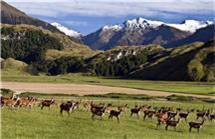Raised in New Zealand
Deer Farming in New Zealand
An introduced species
Deer are not native to New Zealand. Deer were introduced to New Zealand in the late 1800's from Great Britain and released into the wild to provide sport for the European settlers. Eventually the rapidly multiplying wild deer numbers became a problem as their uncontrolled browsing was damaging New Zealand's native forests. Starting in the 1930's the government enlisted professional hunters to cull the population.
During the 1960's entrepreneurs recognized the opportunity to ship to Europe where venison was traditionally a favoured dish. Hunting became so lucrative that the deer population dwindled to the point that deer farming to supply venison to the rapidly growing European market became economically viable. In 1970 the first deer farming license was issued.
A modern food industry
Today there are about 1.2 million deer on around 3,000 farms in New Zealand. New Zealand is the number one worldwide source for farm raised venison. In addition to the U.S., Germany, Switzerland, France, and Sweden are major importers of New Zealand venison.
Venison processing plants are efficient, modern food processing facilities, meeting the highest food safety standards demanded by European Union, US and other national food inspection agencies.
A wide variety of ready to cook venison cuts are produced to meet the needs of individual customers around the world.

There are around 3,000 deer farms in New Zealand spread from the top tip of the North Island to the southern plains of the South Island. About 3/4s of New Zealand deer farms are in the South Island. Most deer are farmed in the more mountainous regions of Canterbury, Otago and Southland.